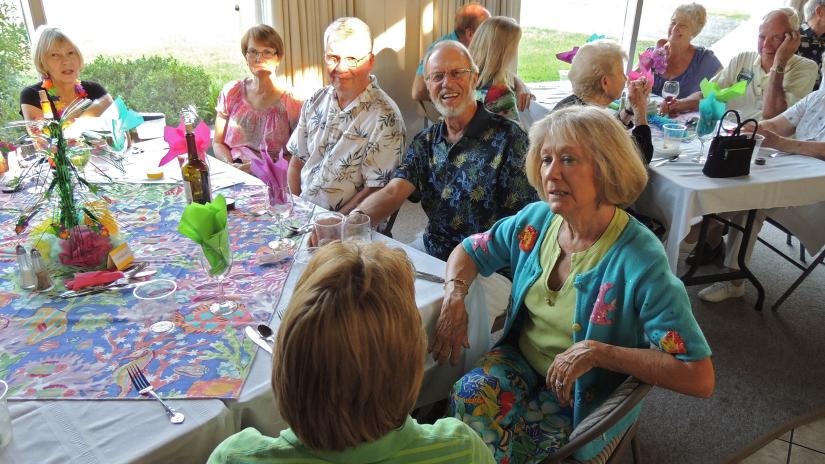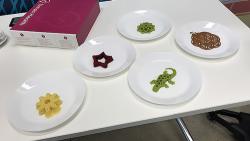It’s a question that’s been nagging at UTS Professor Bronwyn Hemsley for some time: can 3D food printers be used to produce nutritious, tasty meals that are safe for people with swallowing difficulties?
And for dinner? A little of what you might fancy

Researchers
Professor Bronwyn Hemsley, UTS
Professor Susan Balandin, Deakin University
Professor Abbas Kouzani, Deakin University
Dr Stuart Palmer, University of Melbourne
Dr Stephen Dann, Australian National University
Funders
NHMRC Equipment Grant Scheme
UTS Seed Funding
Imagine looking down at your dinner plate and seeing nothing but brown or indistinguishable mush. Now imagine eating the same thing every night for the rest of your life. For people with dysphagia, or difficulty swallowing, the monotony of unappealing meals can be a reality that greatly impacts their quality of life.
Dysphagia impacts an estimated 2 million Australians, including people with cerebral palsy, intellectual disability, autism, stroke, or traumatic brain injury, among others. People with dysphagia are often restricted to eating pureed food, resulting in little choice or variety at mealtimes.
“People on long-term pureed diets often get very little variation in the food on offer. They might get no choice over what they can have to eat or the way that the food looks on the plate,” says Professor Bronwyn Hemsley, a speech pathology researcher in the Graduate School of Health.
But an unlikely solution might be right around the corner, thanks to the rise of additive manufacturing—or, as it’s commonly known, 3D printing.
“Our social culture is so tied up with sharing food and drink. Our previous research shows that people with swallowing disability who are on modified diets often have to choose between eating and talking, so they’ll avoid social situations involving both, or where they might experience the embarrassment of coughing and choking on food,” Professor Hemsley says.

3D printed corn, beetroot, peas and bean paste at the Umps Health Experience Centre
“3D food printing could be a way to increase the visual appeal of pureed food, and it’s possible to inject additional nutrients and tastes into the pureed foods produced,” Professor Hemsley says.
“3D food printers are controlled by a computer and, via a computer interface, users can design their own food shapes, select existing food shapes and recipes from a library of designs, and share their designs with other people online.”
The idea isn’t without precedent—3D food printing is already taking off in the production of custom-made chocolates and sugar creations, but Professor Hemsley and her colleagues are the first research team worldwide to explore the concept of 3D food printing in a disability context.
Professor Hemsley recently received funding through the NHMRC Equipment Grant scheme and seed funding from UTS to purchase and trial a domestic 3D food printer. As a first step, she and her multi-university team will establish processes for the design, preparation and printing of pureed meals for people with swallowing difficulties.
“We’re drawing in researchers across multiple disciplines, including engineering, health economics and marketing, who can help us with that testing and implementation,” Professor Hemsley says.
“Once the process has been fine-tuned, the researchers will work directly with people with swallowing disability to ‘taste test’ and determine the safety of the food.”
The work will follow on from a series of pilot studies that Professor Hemsley and her colleagues at Deakin University have recently completed, including the production of a pavlova in the shape of Australia and a multi-ingredient, 3D-printed meal comprised of tuna, pumpkin and beetroot.
The impacts of repetitive and visually unappetising food can be significant—some people with swallowing difficulty may stop following their recommended diet, increasing the risk of choking and chest infections. Others may withdraw from social situations involving food, or reduce their food intake, leading to weight loss and other health complications.
“Our social culture is so tied up with sharing food and drink. Our previous research shows that people with swallowing disability who are on modified diets often have to choose between eating and talking, so they’ll avoid social situations involving both, or where they might experience the embarrassment of coughing and choking on food,” Professor Hemsley says.
The research will demonstrate whether 3D food printing offers a suitable and safe option for the provision of pureed foods, and whether user participation improves the mealtime experience and quality of life for people with swallowing difficulty at home, in disability services and in aged care settings across Australia.
Contact us
Find out how UTS can help you design, develop and implement new innovations in the disability sector. Contact rio@uts.edu.au or phone +61 2 9514 9681.
Image credits
Photographer (main image): poaphotos on Flickr
Food photo courtesy of Adam Jahnke, CEO Umps Health
